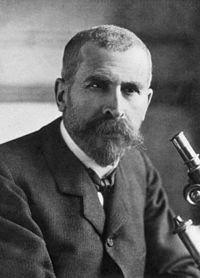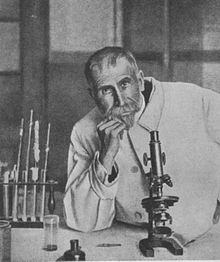Émile Roux
Émile Roux | |
|---|---|
 Roux (c. 1900) | |
| Born | 17 December 1853 |
| Died | 3 November 1933 (aged 79) Paris, France |
| Nationality | French |
| Known for | Pasteur Institute anti-diphtheria serum |
| Awards | Copley Medal (1917) |
| Scientific career | |
| Fields | Physiology, bacteriology, immunology |
Pierre Paul Émile Roux
Early years
Roux was born in
In 1878, Pierre Paul Emile Roux married Rose Anna Shedlock, but it was kept a secret. Shedlock met Roux at the Paris medical school. Shedlock then died in 1879 of tuberculosis. In an inaccurate biography, Roux's niece stated that Shedlock contracted tuberculosis from Roux. However, this is unlikely, given that Shedlock had symptoms before marrying Roux.[5] According to his niece, Roux allegedly believed that marriage was an opportunity for women to satisfy their "deepest aspirations," while for men it was "mutilation".[4]
Work with Pasteur
Duclaux recommended Roux to Louis Pasteur, who was looking for assistants, and Roux joined Pasteur's laboratory as a research assistant from 1878 to 1883 at the
Louis Pasteur and Émile Roux were sometimes in disagreement in their approach to disease. Pasteur was an experimental scientist, whereas Roux was more focused on clinical medicine. They also held different religious and political beliefs, with Pasteur being a right- leaning Catholic, and Roux being a left-leaning atheist. Given their many differences, they clashed often as they worked towards vaccines against anthrax and rabies. The main issues between Roux and Pasteur regarded the ethics of human experimentation, specifically, the amount evidence from animal experimentation on the rabies vaccine needed in order to justify giving the vaccine to humans. Roux was more reluctant to give the vaccine to humans without further evidence that it was safe in animals.[4]
In 1883, he presented a doctoral dissertation in medicine titled Des Nouvelles Acquisitions sur la Rage, in which he described his research on rabies with Pasteur since 1881, which led to the development of the first vaccination against this fearsome disease. Roux discovered the idea of intracranial transmission of rabies, which paved the road for many more Pastorian milestones in research.[4] Roux was now recognized as an expert in the nascent sciences of medical microbiology and immunology. With Pasteur's other assistants (Edmond Nocard, Louis Thuillier, who died while in Alexandria after contracting the disease, and Straus), Roux traveled in 1883 to Egypt to study a human cholera outbreak there, but they were unable to find the pathogen for the disease, which was later discovered in Alexandria by the German physician Robert Koch (1843–1910).[1]
In 1883 and for the following 40 years, Émile Roux became closely involved with the creation of what was to become the
Diphtheria research
The development of a diphtheria anti-toxin serum was a race between researchers Emil Behring in Berlin, and Émile Roux in Paris. They both developed it nearly simultaneously. However, the serum was marketed differently in each country. In Germany, the serum was marketed in a private business setting, whereas in France, the serum was distributed through a communal health care system.[8] The race to develop the diphtheria anti-toxin serum was considered a national rivalry, although each team of researchers adopted each other's experimental practices and built off of each other.[9] In a controversy, the first Nobel Prize for Physiology and Medicine was given to Emil Von Behring for his work on the serum therapy for diphtheria. Roux had been nominated in 1888 for the isolation of the diphtheria toxin, but didn't win the prize in 1901 because his discovery was deemed to be too "old." Over the years, Roux came close to the Nobel Prize but never won.[10]
Also in 1883, Roux published, with
Other research and later years
In the following years, Roux dedicated himself indefatigably to many investigations on the microbiology and practical immunology of tetanus, tuberculosis, syphilis, and pneumonia. He was elected a member of the Royal Swedish Academy of Sciences in 1900. In 1904, he was nominated to Pasteur's former position as General Director of the Pasteur Institute.[1]
In 1916, he moved to a small apartment in the
Awards and honors
- In 1917, he received the Copley Medal for his outstanding achievements in research.[11]
- Asteroid M.P.C. 103971).[13]
- The Roux culture bottle, a flask for culturing cells, is named after him.[14]
Gallery
-
An injection against croup at the Hôpital Trousseau in Paris, with Roux observing, by P.A.A. Brouillet in 1893
-
Dr. Emile Roux, Albert Edelfelt, 1896
-
Office in 1906
-
18th and 19th Century Medicine by Veloso Salgado in 1906, Pasteur at the center and Roux kneeling in front with the rabbit
-
Friendly caricature of members of the Academy of Medicine designed by Hector Moloch and published in the journal Chanteclair in 1910
-
Roux, unknown date
-
25th anniversary of the Pasteur Institute on 15 November 1913
-
Roux in 1927
References
- ^ .
- ^ Pierre Paul Émile Roux. Biographie. Institut Pasteur, Paris.
- PMID 20319369.
- ^ PMID 2212608.
- S2CID 43576406.
- PMID 18641790.
- ^ "Emile Roux, pilies de l'aventure Pasteur". Pasteur. 9 November 2018. Retrieved 11 July 2020.
- S2CID 423178.
- S2CID 23575164.
- OCLC 1147879148.
- ^ "Notes and Records of the Royal Society". Royal Society Publishing. Retrieved 5 February 2009.
- ^ "293366 Roux (2007 EQ9)". Minor Planet Center. Retrieved 12 September 2019.
- ^ "MPC/MPO/MPS Archive". Minor Planet Center. Retrieved 12 September 2019.
External links
- English biography of Pierre Paul Émile Roux. Pasteur Brewing
- Bibliography of P.P.E. Roux. Pasteur Institute.
- Paul de Kruif Microbe Hunters (Blue Ribbon Books) Harcourt Brace & Company Inc., New York 1926: ch. VI Roux and Behring: Massacre the Guinea Pigs (pp. 184–206)

![An injection against croup at the Hôpital Trousseau [fr] in Paris, with Roux observing, by P.A.A. Brouillet in 1893](http://upload.wikimedia.org/wikipedia/commons/thumb/5/5e/An_injection_against_croup_at_the_H%C3%B4pital_Trousseau%2C_Paris._Wellcome_V0006764.jpg/339px-An_injection_against_croup_at_the_H%C3%B4pital_Trousseau%2C_Paris._Wellcome_V0006764.jpg)



![Friendly caricature of members of the Academy of Medicine designed by Hector Moloch [fr] and published in the journal Chanteclair in 1910](http://upload.wikimedia.org/wikipedia/commons/thumb/d/d3/Dr._Emile_Roux.jpg/180px-Dr._Emile_Roux.jpg)


